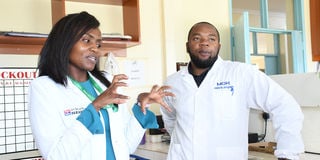Alarm over rise of drug-resistant infections in Laikipia

Pharmacist Dr Edna Kubai and microbiologist Franklin Mugambi speaking at Nanyuki Teaching and Referral Hospital (NTRH). The healthcare practitioners have raised alarm over the rapid rise of patients suffering from drug-resistant infections.
As Kenya marked World Antimicrobial Awareness Week, healthcare practitioners in Laikipia County raised the alarm over the rapid rise in antimicrobial resistance in humans and animals.
Antimicrobial resistance occurs when bacteria, viruses, fungi and parasites change over time and no longer respond to medicines, making infections harder to treat and increasing the risk of disease spread, severe illness and death, the World Health Organization (WHO) says.
As a result of drug resistance, WHO notes, antibiotics and other antimicrobial medicines become ineffective, making it increasingly difficult or impossible to treat infections.
This year’s antimicrobial awareness week – themed ‘Preventing Antimicrobial Resistance Together’ – was marked between November 18 and November 24.
Healthcare professionals at Nanyuki Teaching and Referral Hospital (NTRH) have termed the sharp increase as ‘a silent raging pandemic’, attributing it to misuse of antibiotic medicines by patients.
Dr Edna Kubai, a pharmacist at NTRH, says more patients are suffering from drug-resistant infections.
“The shocking result is that we are struggling to match the pace of restocking the effective drugs as the resistance is even outpacing supply plans. Antibiotics development is a lengthy and very costly affair,” Dr Kubai said.
“As we stand, the discovery of new drugs has slowed down significantly over the past few decades, and this should be a concern for everyone to exercise caution when handling drugs.”
A microbiologist
Data from the NTRH lab shows that the infections are on the rise, said Franklin Mugambi, a microbiologist at the hospital.
“Over a brief period of time, culture and drug sensitivity tests on diverse pathogens show a sharp rise in the number of drugs a single bug has become resistant to,” he said.
“What this simply means is that caregivers have to prescribe even stronger medications, with the options running thin with each passing day.”
If the situation goes unchecked, Dr Kubai warned, it could cripple healthcare systems as it piles pressure on expenditures for drugs with minimal outcomes.
She explained that it is now common to see drugs they can no longer dispense go to waste because they are becoming ineffective.
“We are staring at the possibility of prolonged hospital stays by patients due to poor response to treatment plans, leading to crowding and risks of hospital-acquired infections,” she said.
She added: “Such a situation could trigger disruptions in the entire health ecosystem, with overburdened staff leading to poor service rendering, a recipe for disastrous outcomes such as rising death rates.”
Proper procedures
The medics urged the public to follow proper procedures when seeking health care.
“There is no shortcut to medical intervention. Proper consultation, lab testing, and drug prescription by a qualified team is the only way to tailor effective treatment plans,” Dr Kubai said.
She decried rampant misuse of drugs by the public and by some unethical healthcare practitioners.
Internet-savvy people now visit healthcare centres armed with online-sourced diagnoses and prescriptions.
Healthcare practitioners urged rational use of drugs through antimicrobial stewardship. This means the use of the right drug for the right purpose, dosage, diagnosis, and duration.
“Some usually overlooked habits, such as stopping taking drugs once a patient has recovered, are fanning the drug resistance flame,” Dr Kubai observed.
Antimicrobial resistance (AMR), professionals say, is mainly a problem among young people and that poor medical history collection is also to blame for the rise of infections.
“Unqualified, unethical practitioners have been prescribing second line drugs (broad spectrum) without exhausting first line options. This accelerates AMR,” Dr Kubai said.
Through the One Health Approach, healthcare professionals seek multi-sectoral collaboration to bring actors in human, animal, and plant health together to tame the rising burden of drug-resistant diseases.
WHO has declared that AMR is one of the top 10 global public health threats facing humanity.





